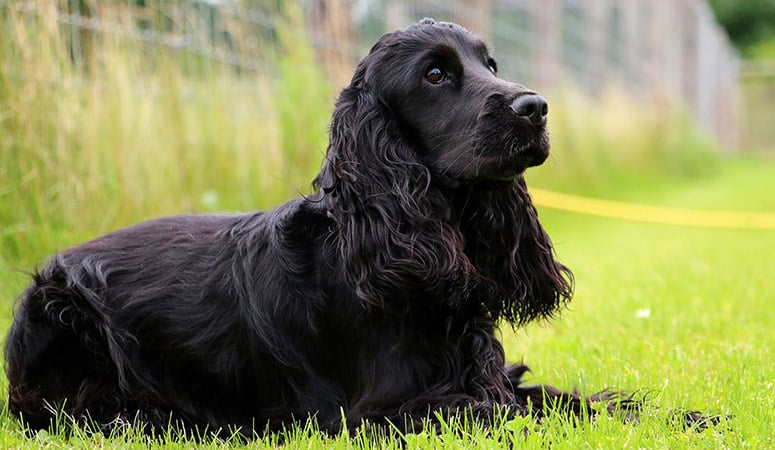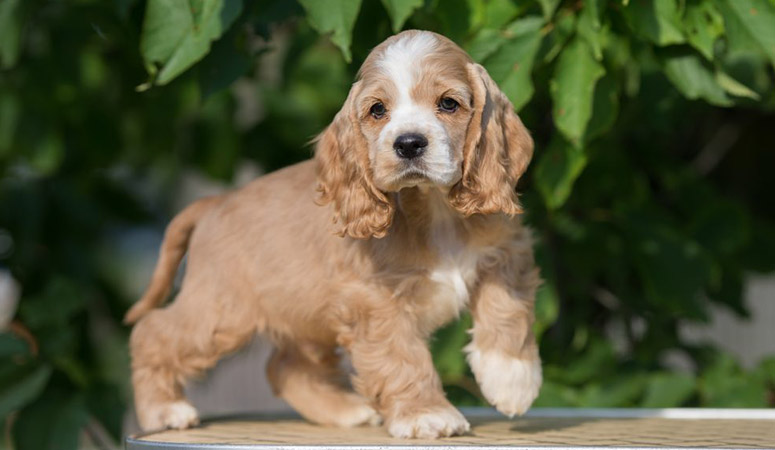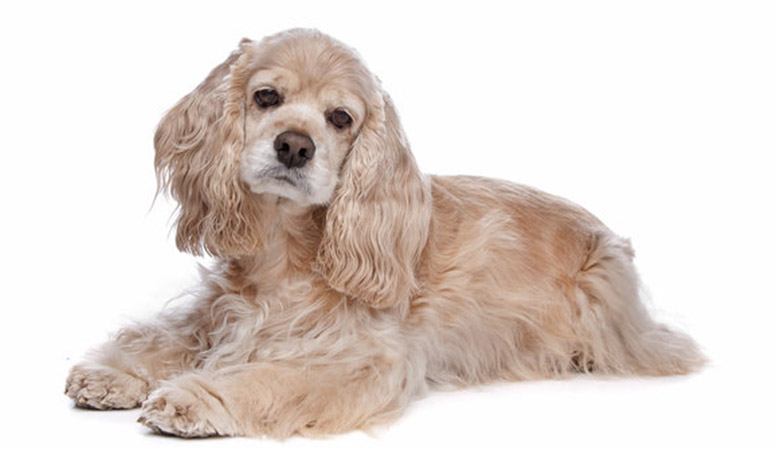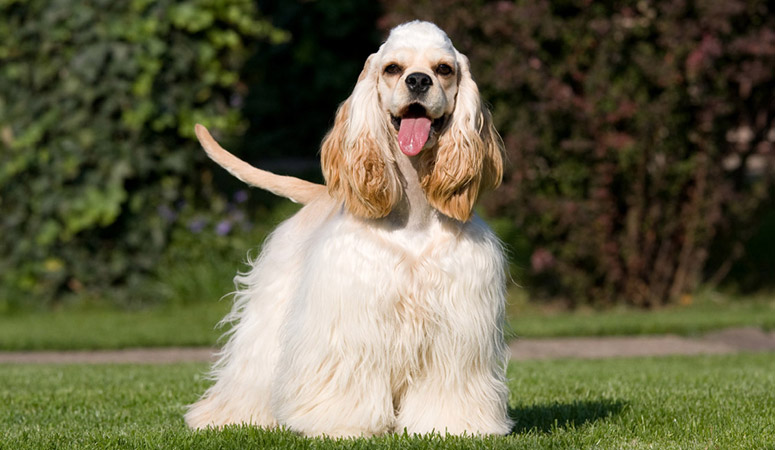Cocker Spaniel
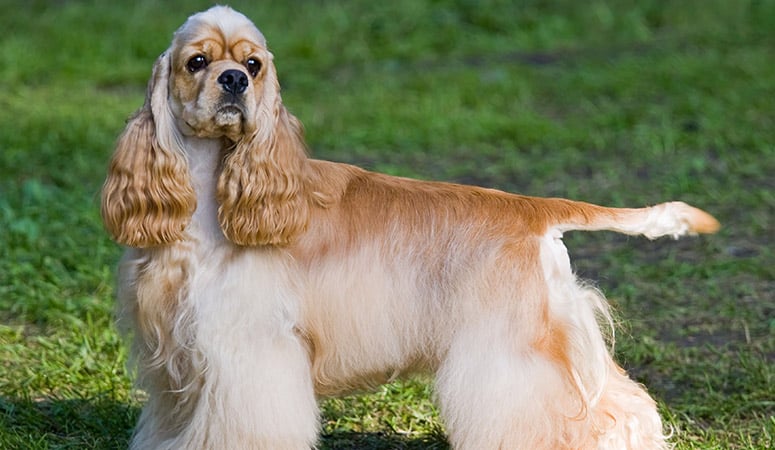
With a sweet temperament, Cocker Spaniel is cuddly and affectionate, fond of participating in activities together with family. As a beloved companion dog breed, they move quickly and a well-balanced body and great endurance, and they are easy to train. The Cocker Spaniel is the smallest member of the Sporting Group.
| Other Names | American Cocker Spaniel, English Cocker Spaniel |
| Color | Black, Liver, Red, Golden, Roan, White, Black&Tan, Liver&Tan, Roan&Tan |
| Height | Males: 14-16 inches. Females: 13-15 inches. |
| Weight | Males: 15-30 pounds. Females: 15-30 pounds. |
| Life Span | 10-14 years |
| Personality | Gentle, Smart, Happy |
| Exercise | Regular Exercise |
| Origin |
| Popularity | #28 |
| Groom Needs | Daily Brushing |
| Kids Friendly | Yes |
| Dog Friendly | Yes |
| Watch Dog | |
| Family Dog | Yes |
| Litter Size | 3–12 |
Cocker Spaniel Pictures
Cocker Spaniel Video
Introduction
Although the name Cocker Spaniel applies to both American and English breeds, it is used exclusively to describe the American Cocker Spaniels in the US. The American Cocker Spaniel is a small hunting dog, swift and sturdy with orb-like eyes that improve the chiseled appearance of their skull. They come in a soft flowing coat that can be trimmed to keep injurious objects from getting entangled in it.
The American Cocker Spaniel comes in a variety of coat colors, including the liver, black, red, and golden. They are merry small-sized dogs, the males of which measure around 14-16 inches standing at the shoulder, and the females run quite smaller at around 13-15 inches. A standard male Cocker Spaniel weighs somewhere between 25 and 30 pounds, where a similar female tags close behind with 21-24 pound-weight.
They have been classed as sporting dogs by the American Kennel Club. A Cocker Spaniel spans through an average of 11-14 years before death follows.
Living with Cocker Spaniel
Early grooming is necessary for Cocker Spaniel to develop a good health habit, which can help him regard grooming as a normal part of his life. Many breeders will help the dog brush, bathe and trim the coat every six to eight weeks with the supervision and approval. Combing the coat is very important, and you can loosen its hair with a slicker brush. But you should keep careful attitude to make sure that you are clear and can see through to the skin everywhere. When you see snarls, pick them apart and at the tips of the coat, and then comb through. Besides, you should be very careful when combing the ears because the skin of the edges is thin and easy to be pierced by too-vigorous combing.
Daily brushing with quality dog shampoo at home is also needed to keep the coat free of mats and tangles. Nail trimming once a month and checking ears once a week are required to remove the dirt, bad odor and redness, which is beneficial to prevent infection. You can wipe the ears with a cotton ball that is dampened with pH-balanced and gentle ear cleaner to reduce some problems.
As a member of sporting breeds, the Cocker Spaniel should keep good muscle tone by regular exercise. They don’t need vast space to roam, but the room should be done in a yard and last 30 minutes to keep them happy and trim. Usually they are not pleased to be left alone, or they will keep barking or digging to make them amused. So as a responsible breeder, you need to take you dog to take part in your family activities.
The Cocker Spaniel Walking love to please and play with their people. Walking and retrieving a ball or toy are also good exercise options, and the Cocker Spaniel will enjoy spending time with family very much. A canine companion can make them exercise each other.
The Cocker Spaniel has a hearty appetite, so he’s easy to overeat. Proper daily amount recommended by the experts is 1.5 to 2.5 cups of high-quality dry food per day. The amount and proportion should vary with the dog’s age, size, build, activity level and metabolism.
Like human, they are individuals and need different food. So to keep a good health, the breeder should choose the best diet for you dog. You should notice the ingredient of the food when you buy dog food or ask the veterinarian for advice. Before choose the food, consider individual sensitivities, likes, and needs. A chicken and rice–based food could be a good starting point. Mind your dog’s weight and don’t overfeed, or it can leads to overweight or causes some health problems.
The most common disease that causes Cocker Spaniel’s death is cancer, and old age is the second one. This breed is susceptible to several health problems. Some other common diseases that Cocker Spaniel could suffer from include eye problems (progressive retinal atrophy, cataracts, glaucoma and eye abnormalities), AIHA, hypothyroidism, primary seborrhea, allergies, idiopathic epilepsy, canine hip dysplasia and Patellar luxation.
Follow veterinarian’s proper procedures to bath or clean the Cocker’s ear canals will help prevent infections effectively. Grooming the Cocker’s coat can help keep from mats and avoid related skin problems. Besides its ears are long, so it’s easy to cause potential health problems. You should check your Cocker’s ears every week. With good longevity, the breeder must be conscientious and take the dog to finish health tests regularly, such as hips, patellas, eyes and ophthalmologist evaluation.
Total Annual Cost: $3177.9
Cost is estimated for the first year and may vary depending on many factors, such as dog food, health care, leash, collar, licensing, possible fencing, crates, training and obedience classes, dog-walking, grooming, treats, toys, flea, tick, and heart-worm meds, microchips, etc.
With a soft personality, the Cocker is a good companion for people and easy to train. But be sure not to use harsh training methods but gentle, consistent training that would not make him fearful. Early socialization and training of obedience, agility and field work, is necessary for the dog to develop good behaviors and appropriate canine manners. The Cocker was bred to be a hunting dog and sometimes he will chases birds or other animals that he meets when you take a walk with him. But you should keep in mind that when you aren’t in a fenced area you’d better keep your Cocker on a leash.
Cockers are rather easily motivated with food rewards, play and praise. Also as a good candidate, he excels in many canine sports, such as agility and obedience competitions, flyball, hunt tests, and tracking. Just like most dogs, the Cocker will behave better when you keep him active. But if you leave him alone and make him bored, he would have some behavior problems, for example digging, chewing and barking. The breeder needs great patience to get better training result.
History
The American Cocker Spaniel is a descendant of the old English spaniels, themselves related to the old Spanish bird dogs, the Epangeuls (dating back to early 17th century). Those days, a spaniel was considered to be any flusher dog, that is, dog breeds that help in catching birds. All spaniels were once spaniels until around the 1890s when they were classified into distinct groups, namely the Cocker Spaniel, Springer Spaniel, and Hawking Spaniels.
Originally, before 1880, the precise basis for placement into the categories was unclear– size was more important than ancestry to determine the category into which a dog would enter. At that time, a Cocker Spaniel was generally designated as a spaniel dog which weighed below 25 pounds.
History has it that, certain English travelers on Pilgrimage to America had taken their dogs aboard the Mayflower with them on their journey. These dogs were believed to be English Cocker Spaniels and earliest ancestors of the American Cocker Spaniel breed. These earlier hybrids were further bred to enhance the desired qualities of American breeders. It was only a matter of time until the American breed showed a wide divergence from their English Cocker Spaniel ancestors.
The American Cocker Spaniel was bred to serve on the fields as work dogs and at home as companion dogs, and it continued that way for some time until it first appeared in the show ring. Breed enthusiasts took to this breed due to its show-worthy characteristics. As time passed, the English Cocker Spaniel dominated fieldwork, while the American Cocker Spaniel attended the shows. This led many breeders, at the time, to breed American Cocker Spaniels for the purpose of dog shows rather than for the original herding and work dog abilities they were popular for. This meant, dome-skulled and flowing coated varieties became popular among American Cocker Spaniels.
Recently, a few concerned breeders had set out to groom American Cocker Spaniels with the original characteristics that were peculiar to the breed as hunting dogs.
Helpful Information
Breed Club: THE AMERICAN SPANIEL CLUB, INC.
Breed Club Link: https://www.americanspanielclub.org/
Breed Club Rescue: AMERICAN SPANIEL CLUB FOUNDATION, INC.
Breed Club Rescue Link: https://www.asc-f.org/content/ascf-rescue

